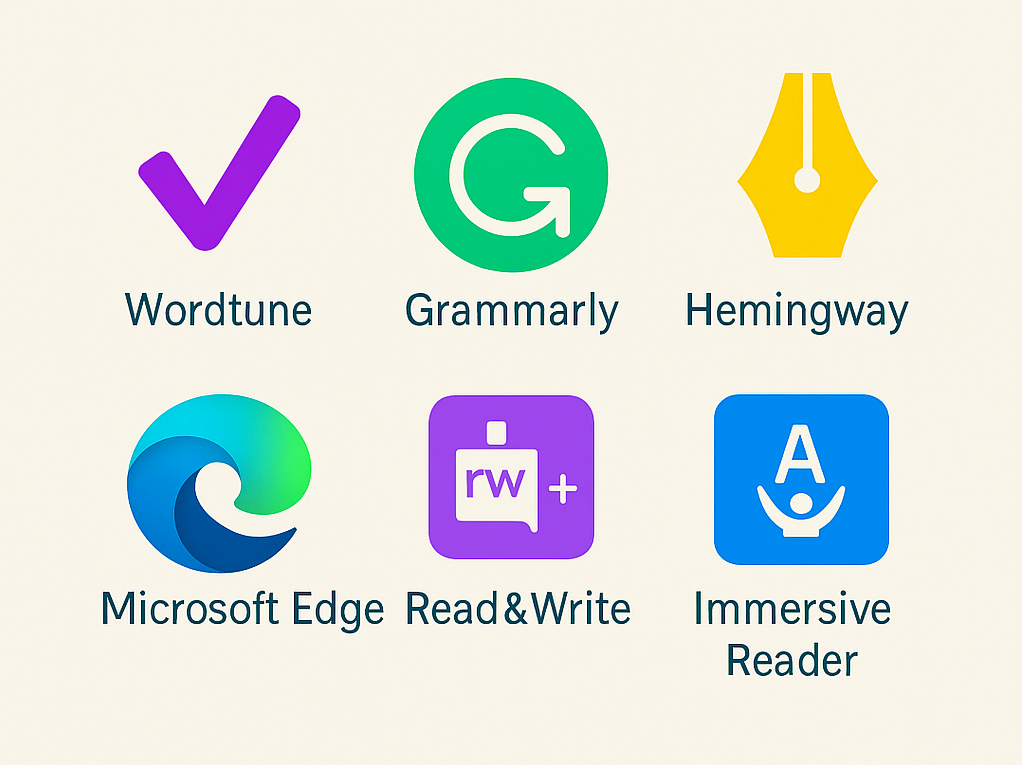Read and Write Smarter: Free Tools Every Student Should Know About
Reading dense academic texts and writing polished essays isn’t always easy — especially when you’re balancing deadlines, distractions, and different ways of learning. Maybe you’re struggling to unpack complex readings, sharpen your grammar, or organise your thoughts into clear, confident writing. The good news? There are plenty of free tools that can help you study smarter, not harder. We’ve rounded up some of the best ones below.
📚 Microsoft Immersive Reader
What it does: This hidden gem reads text aloud, breaks words into syllables, highlights grammar, and even changes line spacing and background colour to suit your reading needs.
Great for: Visual stress, dyslexia, and improving reading fluency.

How to access in Microsoft Word: Select ‘View – Immersive Reader‘ or Edge Browser capital ‘A’ with two curved lines above it.
📄 Microsoft Edge PDF Reader – Read Aloud + Annotation
What it does: Open your PDFs directly in Microsoft Edge (yep, the web browser!) and access built-in read-aloud features, text highlighting, and note-taking.
Great for: Students with visual impairments, dyslexia, or focus challenges, and anyone who prefers listening to reading.
How to access: From your OneDrive in Edge find your PDF, choose the three dots – open in browser. You will see a tool bar in the top left corner. This tool bar includes features such as highlight, draw, add text, read aloud, and translate. See below.

✨ Quillbot – Paraphrasing and Grammar Help in a Click
What it does: Quillbot is an AI writing assistant that helps you reword, shorten, expand, or clarify your writing. It’s a fantastic tool for understanding tricky text by paraphrasing it into simpler language — or for polishing up your own work.
Great for: Students who need help rephrasing academic language, English as a second language speakers and anyone looking to boost clarity, grammar and flow
How to access: Free to use online (with limited features) 🔗 https://quillbot.com
🧠 Wordtune – Smarter Rewriting and Summarising
What it does: Wordtune helps you rewrite or simplify sentences, making reading and understanding tricky texts that bit easier. It can also summarise longer articles or paragraphs.
Great for: Neurodivergent students, English as a second language speakers and anyone who wants help breaking complex writing into manageable chunks.
How to access: Free Chrome extension 🔗 https://www.wordtune.com
🔍 Grammarly – Clarity Checker & Readability Support
What it does: While known for fixing spelling and grammar, Grammarly also gives helpful feedback on sentence clarity and tone, helping you make sense of academic writing and improve your own.
Great for: Students who want clearer writing and help understanding grammar in context.
How to access: Free browser extension or desktop app. (Paid version offers more, but the free version works well for most needs.) 🔗 https://www.grammarly.com
✍️ Hemingway Editor – Making Writing Bold and Clear
What it does: Hemingway Editor simplifies complicated writing. It highlights overly long sentences, passive voice, and hard-to-read phrases.
Great for: Anyone who struggles with long-winded texts or wants to learn how to write more clearly themselves.
How to access: Free web version available online (desktop version is paid). 🔗 https://hemingwayapp.com
🛠️ Read&Write for Chrome – Toolbar for Reading, Writing & Studying
What it does: This extension adds a floating toolbar to your browser with features like text-to-speech, dictionary, picture dictionary, screen masking, and more.
Great for: Neurodiverse students, students with dyslexia, or anyone who benefits from multi-sensory learning support.
How to access: Read&Write is now available by default on all QUB-managed computers and browsers (Chrome and Edge) — just look for the purple Read&Write puzzle-piece icon in your browser toolbar.
Students can also download the Read&Write extension for Chrome or Edge on their own devices. To unlock the full version, simply sign in with your QUB email address and password via Microsoft login.
👉 Check out our Guide to Read&Write
📖 BeeLine Reader
What it does: BeeLine Reader uses colour gradients (like red fading into blue) at the start of each line of text. This subtle visual cue helps guide your eyes from the end of one line to the start of the next, making reading smoother and less tiring.
Great for: Students with ADHD or visual tracking issues, Neurodivergent students and anyone reading lots of text on-screen
How to access: available as a free Chrome extension; works on most websites, Google Docs, and some PDFs
🔗 https://www.beelinereader.com/
🧩 Want More?
There are so many ways to personalise your learning – and the best tools are the ones that make reading easier for you. If you’re not sure where to start, book a session with the Assistive Technology Coordinator or check out our other posts: Assistive Tech for Academic Reading and Understanding and Assistive Tech for Reading, Writing & Summarising.
Let the tools do the heavy lifting, so you can focus on learning. 💪📖
Support Channels
- For more information and guidance on supporting students with assistive technology, please contact the Assistive Technology Coordinator.
- IT Helpdesk: For licensing issues or technical support, reach out to the QUB IT Helpdesk.
Discover more from Assistive Technology Hub
Subscribe to get the latest posts sent to your email.

